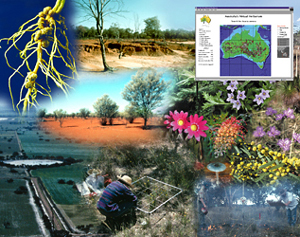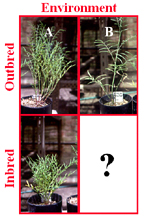Ecosystem Restoration

Restoration of Australia's native plant communities and the landscapes
they occupy is a land management imperative. Retention of native perennial
cover is crucial for biodiversity conservation and the continued provision
of the biological and physical services that it provides for our agricultural
production systems. Effective landscape management is a multi-step process
involving: (i) identification of a target landscape's role (e.g. conservation,
recreation, production); (ii) quantification of the current extent and
condition of remnant vegetation; (iii) rehabilitation to improve the
quality and long-term viability of existing remnants, and large-scale
revegetation to increase regional cover.
An ever-expanding effort is going into remnant rehabilitation as well
as on ground revegetation. However, quantitative research on how to
maximise the success of critical revegetation and rehabilitation projects
is generally lacking. In particular, two areas of research that hold
great promise for achieving these goals in a cost-effective and timely
fashion are: (i) genetic issues to do with seed quality provenance,
and; (ii) re-establishing the symbiotic plant-soil microbe relationships
on which many key ecological processes are based.
TOP
Genetic Provenance Guidelines for Sourcing Native Plant Seed
With regard to sourcing seed for revegetation or restoration two genetic
issues are of primary importance: (i) fitness (how vigorous the genotype
is), with the main problem being avoidance of inbred seed that give
poor germination and growth due to low heterozygosity and; (ii) provenance
(ensuring that the seed chosen to be sown in a particular area are adapted
to local environments). Current seed sourcing practices acknowledge
these potential problems by recommending a 'precautionary approach'
to collection – sourcing seed only from large populations (probably
outbred) within a few kilometres of the target sites (probably locally
adapted) for replanting.
Although intuitively appealing, such guidelines are based on very little
information about the geographic scale of genetic differentiation within
the Australian flora. For many species that probably have relatively
little local adaptation the precautionary approach is likely to be unnecessarily
restrictive, imposing expensive logistical constraints on seed sourcing
activities that have no biological value. For those that do show significant
small-scale genetic variation of ecological importance, and which may
very well be obligate inbreeders, locally sourced seed, even if from
mildly inbred populations, may be more appropriate than seed from large
populations that are further away from the planting area. Clearly the
potential for tradeoffs between inbreeding and provenance are very real.

This problem is illustrated by the case of Swainsona recta,
a grassland herb targeted for restoration in southeastern Australia.
For this species, seed collected from small populations have low germination
and poor growth relative to those from large populations due to high
levels of inbreeding. In the southern part of the range, only small
populations remain, so it has been proposed to collect vigorous outbred
seed from large northern populations. However, common garden growth
studies show significant morphological differentiation between northern
and southern populations that is probably of ecological significance.
Evidence of similar effects exist for Acacia acinacea, an important
revegetation species being used extensively by Greening Australia
in the Murray-Darling Basin.
The purpose of this research project is to combine high-resolution genetic
markers and growth studies (provenance trials) to identify characteristics
of remnant populations that will make them sources of high genetic quality
seed, and to determine over what geographical scales adaptively significant
genetic differentiation occurs. This information will then be used to:
(i) provide quantitatively based genetic provenance maps for key species
that can be used to guide seed collection activities and; (ii) develop
general collecting guidelines for different ecological classes of species
that will maximise the likelihood of collecting high genetic quality
seed that is locally adapted.
By addressing issues of genetic fitness and provenance simultaneously
for a range of key native species commonly used in revegetation, it
will be possible to develop a general set of guidelines providing information
about what characteristics make a population a likely source of outbred
'fit' seed, and how far can that seed be moved around the landscape
and still remain locally adapted. Using such information as a basis
for seed sourcing practice will lead to real improvements in revegetation
success.
TOP
Using Microbial Symbionts to Improve Revegetation & Rehabilitation of Australian Landscapes
A second major knowledge gap is information on symbiotic interactions
between plants and soil organisms (mycorrhizal fungi, nitrogen-fixing
actinomycetes and rhizobia). These relationships promote rapid early
growth and increased survival extending beyond host plants to other
species in the community, and are likely to significantly impact on
remnant structure and viability. In fact, many plant species important
in early phases of re-establishment are themselves dependent on these
symbioses. However, these micro-organisms rapidly vanish from agricultural
soils, particularly where native shrubs have been cleared through cropping
or where continual grazing has occurred over long periods. As a result,
beneficial symbionts may be absent from disturbed soils where revegetation
is most crucial.
On-going research is exploring how plant-microbe interactions can be
used to improve the effectiveness of revegetation programs, and to determine
when it will be necessary to inoculate soils with appropriate symbionts.
We are in the initial stages of a large-scale collaborative field trial
with Greening Australia Victoria
and the North
Central Catchment Authority in Victoria that will provide an opportunity
to assess the value of using native shrubby legumes and rhizobia in
revegetation efforts (with a particular focus on areas where dryland
salinity is a major issue). The project involves 6-10 Acacia
species for which we are currently isolating appropriate rhizobial strains,
as well as a range of Eucalyptus spp. and other non-legumes.
The trial is being carried out across 3 geographically distinct areas
within the catchment covering a range of soil and moisture regimes.
Replicated sites using inoculated and uninoculated Acacia seed
are being set up within each area, and a range of information on
the abundance of native rhizobia, germination, growth and survival (of
both legume and non-legume species) collected over an 18-24 month period.
Scientific Staff: Broadhurst, Burdon, Thrall, Young, West
